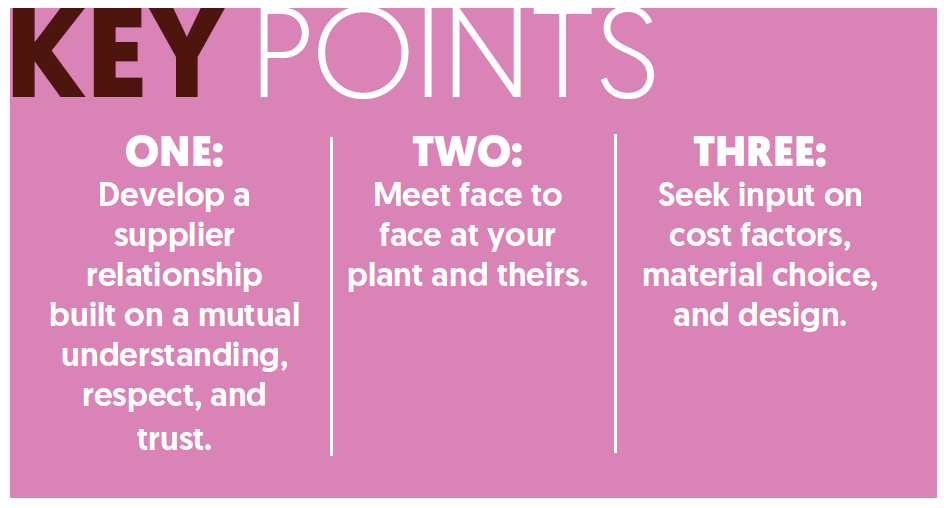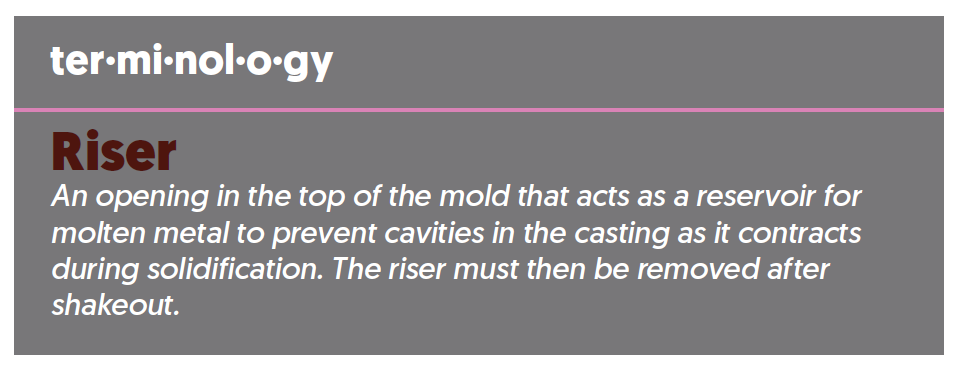Purchasing Points for OEMs
Advice from a senior quality engineer highlights ways to make the most out of your casting supplier relationship.
Relationships often are the key to success in business. Whether seeking a new supplier for cast metal components or optimizing an existing supply chain, certain actions can benefit both sides of the equation and, ultimately, the end customer.
Develop Long-Term Relationships
Take time to invite a supplier’s employees to your plant to demonstrate what you do and what you make. Do not limit this invitation to executives but work to include shop floor supervisors and key employees who are producing your cast product every day. Once in your facility, they can view their delivered product as more than just a metal casting; it’s a real part with a true end use. I worked in a steel foundry for more than 20 years and, after time, parts just become parts.
Work with these people and try to understand their problems and issues in a positive way. When issues do come up requiring a more serious conversation, handle these issues in a manner that does not place you in the light of a tyrant. Every issue you encounter can be corrected if dealt with as a professional. You and your supplier are a team truly after the same goals: on-time delivery, quality levels within specifications and a solid working relationship that grows the business. Your ability to work with your supplier can be either a catalyst or a wedge in this process.

It is critical to establish a clear set of expectations with your supplier early in the relationship. Again, this does not warrant behavior that in some way indicates you will always be right and they must always bow down to your requests. This is a time to express your delivery, quality and pricing expectations that will drive the account and play a key role in developing your relationship going forward. As in any relationship, open and honest communication is critical. Work to establish this with your supplier and you will find your relationship in good standing.
Take a Tour
On one planned visit to my largest casting supplier, I took the opportunity to invite several others in the company to join me. This group included members of our engineering design team, procurement personnel and a member of our planning group. I used this visit as a chance to expose the group to the metalcasting operation and the complete process from pattern prep to shipment.
The post-visit feedback from my group was outstanding. The group had not only gained knowledge of the casting operation, but it gave them a new appreciation for the entire casting process. They were exposed to new technology and process improvements created through lean concepts.
The educational adventures helped my team view the metalcasting process as the sophisticated, leading-edge operation it is.
Take advantage of these opportunities to expose and educate your company in metalcasting.
Visits to your casting supplier also serve as an opportunity to look into the processing used to produce your cast part. In some cases, you might find an operation that adds no value to your part based on its end use. For example, your metalcaster might be performing heavy grinding on a surface you will end up machining later, or processing a riser contact flush on a machined surface. These are opportunities to help reduce costs. Understanding your parts’ uses and the processes used at the metalcaster are the basis for beginning cost or lead time reduction efforts.
This same concept applies to your casting designs. Your engineering group will work to design a component that meets the design needs, but is it a good casting design that takes “castability” into consideration? Collaborative efforts will serve to lower costs, reduce lead times and dramatically improve the first-pass yield of your first article parts.
Talk About Costs
Metalcasters price cast products based on several hard-line factors such as labor, overhead and, of course, profit margins. These are costs the metalcaster has some control of. But other costs are beyond the metalcaster’s control, such as the fluctuating cost of raw materials.
It is important as metalcasting procurement agents that we understand these fluctuating costs, how to track them, how they impact the total landed cost of cast components and how they are paid for.
Raw materials in the metalcasting industry include molding and coremaking sands, chemical binder systems for those sands, base metal (scrap) for melting and the alloying elements that make up the customers’ material specifications. All of these items are commodities that carry a fluctuating price based on global demand.
Fluctuating costs, such as surcharges, are real and need to be covered. Taking the stance that your company will not pay for these costs is not in the interest of your supplier’s long-term health or the relationship between your two companies. Address these fluctuating costs with your metalcasting supplier and choose the method that best fits both your operations. Agree on which items are covered, what is not and a reference both companies will use to track the market.

Look into the Quality Systems
Inquire, review, and understand the quality systems in place at your metal casting suppliers. These systems dictate the level, frequency, and detail the supplier provides in casting your products. Robust systems are continually verifying upstream processes and will employ a high level of documentation to support those inspections. It is critical that a metal casting supplier has these systems in place to assure products are produced consistently and in line with the methods and processes used to produce the first article sample. I personally spend a great deal of time during initial visits and formal audits looking into these systems and processes. In some cases, you may want to use development goals for your supplier in areas you find are weak or understated.
Seek Their Input
Engineering services provided by your metalcaster can play a key role in your efforts to both develop new cast products and improve existing metal castings. Casting providers are the experts in their field and can play a vital role, working alongside your design engineers to develop cost-effective parts that meet the design intent of your engineering group and to provide a part that incorporates “castability.” Metalcasting engineers can provide material suggestions that, while still meeting design requirements, may provide additional cost savings and characteristics like increased strength or wear resistance.
A real-world example of this involved a new steel casting design that required significant wear resistance and serviceability. The initial, unreleased design required the use of three risers to feed the long, narrow plate that provided the wear surface. The metalcaster in this case brought in its engineering specialist to go through the part with the design engineer, purchasing agent and supplier quality engineer.
This resulted in a material change that, in addition to saving significant cost, provided superior wear characteristics. The engineering specialist was able to suggest a modification to the design of the top wear surface on a plate to provide directional solidification that changed the number of risers needed from three to two. The casting specialist also incorporated a cast-on lifting lug that dramatically improved servicing in the field. The overall cost savings associated with this example was more than 40% and helped keep the lead-time to a minimum.
Click here to see this story as it appears in the November/December 2019 issue of Casting Source.